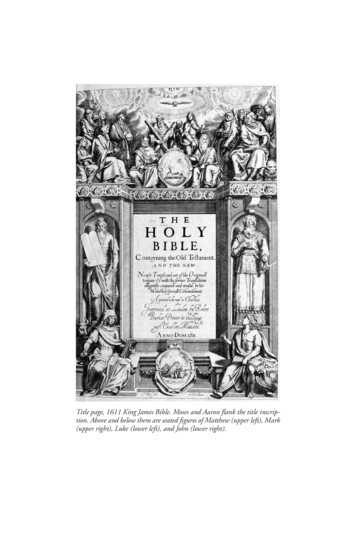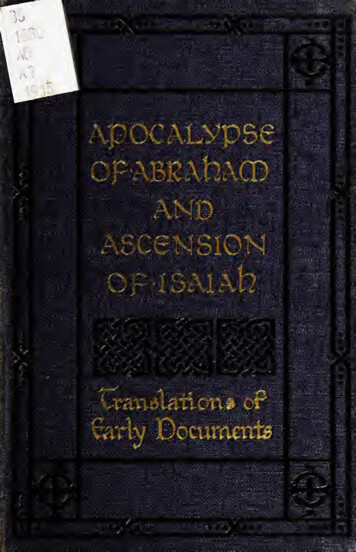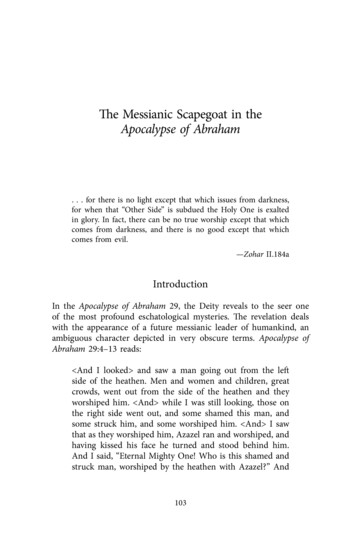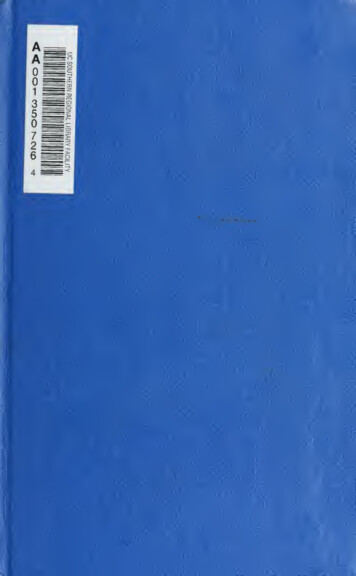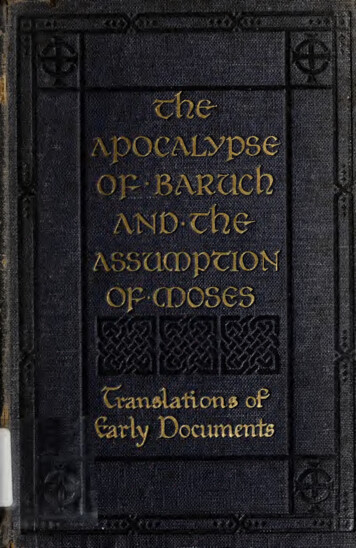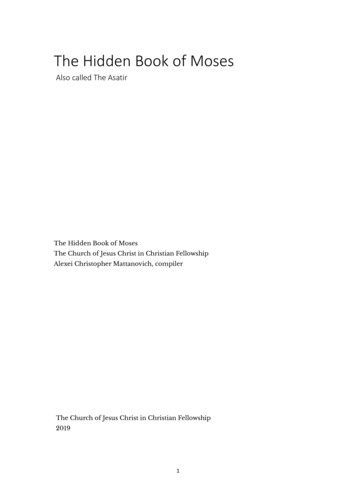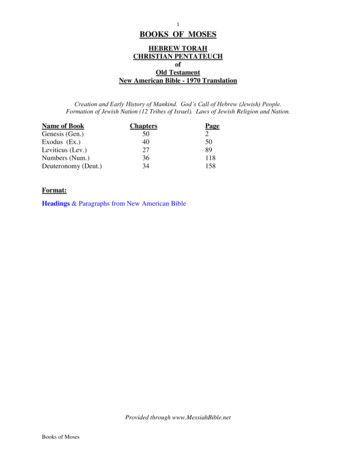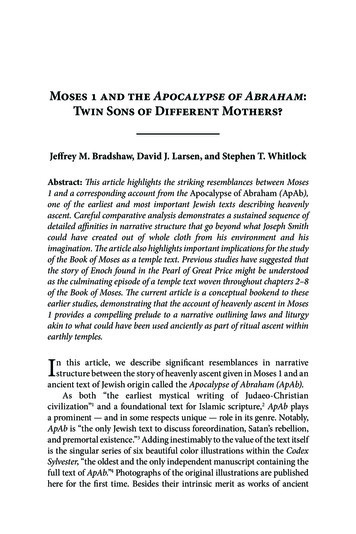
Transcription
Moses 1 and the Apocalypse of Abraham:Twin Sons of Different Mothers?Jeffrey M. Bradshaw, David J. Larsen, and Stephen T. WhitlockAbstract: This article highlights the striking resemblances between Moses1 and a corresponding account from the Apocalypse of Abraham (ApAb),one of the earliest and most important Jewish texts describing heavenlyascent. Careful comparative analysis demonstrates a sustained sequence ofdetailed affinities in narrative structure that go beyond what Joseph Smithcould have created out of whole cloth from his environment and hisimagination. The article also highlights important implications for the studyof the Book of Moses as a temple text. Previous studies have suggested thatthe story of Enoch found in the Pearl of Great Price might be understoodas the culminating episode of a temple text woven throughout chapters 2–8of the Book of Moses. The current article is a conceptual bookend to theseearlier studies, demonstrating that the account of heavenly ascent in Moses1 provides a compelling prelude to a narrative outlining laws and liturgyakin to what could have been used anciently as part of ritual ascent withinearthly temples.In this article, we describe significant resemblances in narrativestructure between the story of heavenly ascent given in Moses 1 and anancient text of Jewish origin called the Apocalypse of Abraham (ApAb).As both “the earliest mystical writing of Judaeo-Christiancivilization”1 and a foundational text for Islamic scripture,2 ApAb playsa prominent — and in some respects unique — role in its genre. Notably,ApAb is “the only Jewish text to discuss foreordination, Satan’s rebellion,and premortal existence.”3 Adding inestimably to the value of the text itselfis the singular series of six beautiful color illustrations within the CodexSylvester, “the oldest and the only independent manuscript containing thefull text of ApAb.”4 Photographs of the original illustrations are publishedhere for the first time. Besides their intrinsic merit as works of ancient
180 Interpreter 38 (2020)religious art, these illustrations shed light on how medieval Christians inthe East understood the older Jewish text in their day.Because studies comparing ancient manuscripts with modernscripture are bound to be controversial, we will begin with a somewhatlengthy section addressing questions about our purpose andmethodology. Why did we undertake this study in the first place, andhow did we carry it out? (Section 1). Following this prologue, we willprovide a brief overview of the genre of “heavenly ascent” from whichboth ApAb and Moses 1 are drawn. We will describe how accounts of“heavenly ascent” are different from but related to the experience of“ritual ascent” as experienced in temples (Section 2). Then, we will showthat each major element (and nearly all of the secondary elements) of thetwo-part narrative structure of heavenly ascent in Moses 1 is mirrored inApAb and, importantly, almost always in the same sequence (Section 3).Finally, we will close this article by addressing the significance of thewitness of ancient manuscripts such as ApAb for the Book of Moses asa whole (Section 4).1. Purpose and MethodologyIn this section, we will address three questions: What can we learn by comparing ancient texts withmodern scripture?Why should it matter whether the accounts in modernscripture have a basis in history?Can comparative research be conducted in a methodologically sound manner?What Can We Learn by Comparing Ancient Texts with ModernScripture?How does this study differ from other comparative approaches? Thereare a variety of comparative approaches that can be used to understandthe texts and translations of modern scripture. For example, in the presentstudy, our primary interest is in comparing Moses 1 with ancient sourcesunknown to Joseph Smith in support of arguments that the Prophettranslated through a process dependent on divine revelation. On theother hand, some comparative studies seek to identify instances whereJoseph Smith might have drawn on the Bible and other resources knownto him as translation aids.5 Yet other studies analyze intertextualitybetween the Bible and modern scripture with the goal of recognizing
Bradshaw, Larson, Whitlock, Moses 1 and Abraham 181and understanding the interplay of these texts, while generally settingaside questions about the translation process.6It is evident that these different realms of comparative study shouldnot be pursued in isolation. Rather, it seems important that those of uswho happen to have a predilection by disposition or training for ancientstudies, history, or literary methods actively immerse ourselves inongoing research in those fields that are not as natural to us, allowing usto carefully weigh and incorporate the respective contributions of eachline of inquiry as we jointly try to form a more comprehensive picture ofmodern scripture and how it came to be. Such a stance requires resistingthe temptation to take the narrower and easier path that is bounded bypersonal inclination or professional discipline because of what J. J. M.Roberts, an eminent scholar of ancient studies, called “a loss of nerve, adecision to settle for a more controllable albeit more restricted vision.”7We agree with Roberts that:scholars must continue to be conversant with fields outsidetheir own discipline. To some extent one must depend onexperts in these related fields, but unless one has somefirsthand acquaintance with the texts and physical remainswith which these related fields deal, one will hardly be ableto choose which expert’s judgment to follow. There is nosubstitute for knowledge of the primary sources.8Indeed, as Roberts argues, the demanding requirements of broadscholarship prompted some more narrowly focused biblical scholarsto retreat from comparative research just as it began to fully bloom.Subsequent analysis of this retreat revealed that:many of the biblical scholars involved no longer controlledthe primary sources for the extra biblical evidence. This lackof firsthand acquaintance with the non-biblical materialis a growing problem in the field. It is partly a reflex of thegrowing complexity of the broader field of ancient NearEastern studies: no one can master the whole field any longer.9Of course, the challenge of mastering the required fields toundertake competent comparative research is in some respects evenmore daunting for students of Latter-day Saint scripture than it is forbiblical studies. Scholars of modern scripture aspiring to comparativestudy need to not only master the Bible and relevant texts and contextsfrom the ancient world but ideally also must be fully conversant withLatter-day Saint scripture and doctrine as well as primary sources
182 Interpreter 38 (2020)relating to the nineteenth-century history of the Church and its widersetting. Moreover, they must wrestle with the fact that modern scriptureis only available in English translation, making direct comparisons tothe languages of ancient texts impossible.To the degree we lack familiarity with each of these allied fields, thereare important matters to which we will remain blind. For example, to theextent we have failed to master nineteenth-century Church history andsources we will not discover connections and influences among eventsproximal to the translation process. Likewise, without expertise inwritings and backgrounds of the ancient world we will miss significantdistal evidence of revealed history and truth that has been restored inmodern scripture. No less important, if we have never learned to read,analyze, and compare the literary features of texts in a careful manner,we will remain blithely ignorant of significant details that sometimesprovide unique clues to understanding.Despite our immediate focus on comparing Moses 1 to ancienttexts, we hope it will be apparent to readers that the present study hasbenefitted from the valuable work of historians and literary specialists.For example, our study of the history of translation process has led usto believe that Joseph Smith was not entirely bound to a character-bycharacter, word-by-word reproduction of source texts in his translations.10He understood that the primary intent of modern revelation is to givedivine guidance to latter-day readers, not to provide precise matches totexts from other times. We also have come to see his involvement in theproduction of scripture as an exhausting personal effort that is betterdescribed in terms of active, immersive spiritual engagement than aspassive reception and recital. Most importantly, as we seek to contributeto a comprehensive picture of the translation process, we have cometo consider significant patterns of resemblance to ancient manuscriptsthat the Prophet could not have known and of unexpected conformanceto conditions imposed by an archaic setting as potential indicators ofantiquity that are best explained when the essential element of divinerevelation is acknowledged.11Why should Moses 1 be compared with a work of pseudepigrapha?While we take the Book of Moses to be a work of scripture informed byauthentic history, ApAb, our primary comparative text, is universallyclassed as a work of pseudepigrapha.The term “pseudepigrapha,” which goes back to the second century,literally means “with false superscription.” In modern times it refers toJewish or Christian writings, generally composed between 200 BCE and
Bradshaw, Larson, Whitlock, Moses 1 and Abraham 183200 CE, that are typically attributed to prominent Old Testament figuresbut that almost certainly did not originate with them.12 For example,the text of ApAb as we have it today, though written in the first personas if Abraham were the author, was not composed by Abraham himself.(However, most scholars would acknowledge the possibility that there areideas, themes, and stories in the account whose origins predate 200 BCE.)Some scholars, having concluded from their study that Joseph Smithcreated modern scripture from a combination of textual borrowingsand his own imagination, apply the term “pseudepigrapha”13 (as wellas the gentler term “midrash”14) to the Book of Abraham and the Bookof Moses.15 Thus, after studying a previous essay comparing the Bookof Moses with pseudepigraphal texts, one reader asked, “Just to makesure I understand this correctly: The evidence of the Book of Moses notbeing pseudepigrapha is that [it] is very similar to pseudepigrapha?”16 Toanswer this question properly, it needs to be restated: “Should it count asevidence that Joseph Smith did not simply invent the Book of Moses if wefind that it resembles documents that are thought to have been inventedbut that are also known to be ancient?” The answer to this question is, wethink, a qualified “yes.”Of course, the only possible gold standard for a comparative studyof Moses 1 would be a similar account of heavenly ascent known tohave come directly from the hand of Moses himself. However, becausewe possess no such manuscript, we are obliged to make the most ofwhat we have. Either we engage with the imperfect collection of extantcomparative cohorts as best we can, or we do nothing at all.Can imperfect documents provide reliable evidence? In light ofour cultural and conceptual distance from the milieu of Moses, we arefortunate that imperfect documents from antiquity may neverthelessprovide keys for understanding that “mysterious other world,”17 evenwhen existing manuscripts were written much later and, not infrequently,have come to us in a form that is riddled with the ridiculous.18 C.S. Lewisonce addressed the potential of ancient sources, even those of poorquality, to inform modern scholars in surprising ways. He illustrated hispoint by saying, “I would give a great deal to hear any ancient Athenian,even a stupid one, talking about Greek tragedy. He would know in hisbones so much that we seek in vain. At any moment some chance phrasemight, unknown to him, show us where modern scholarship had beenon the wrong track for years.”19In a few instances, our experiences in comparing Moses 1 to ApAbhave revealed the truth of Lewis’ claim. For example, as we looked
184 Interpreter 38 (2020)carefully at Moses 1:27, a seemingly gratuitous and initially inexplicablephrase stood out: “as the voice was still speaking.”20 Surprisingly, wefound that ApAb repeated similar phrases in analogous contexts.21This discovery provided a welcome clue to a possible meaning of thisenigmatic phrase in both Moses 1 and ApAb — a finding we will describein more detail below.What kinds of claims can and cannot be made as a result of thestudy? Of course, in using ApAb as the primary basis of comparison,we make no claim that its story of heavenly ascent has come to us ina pristine state, nor that the text must derive from an experience goingback to Abraham himself. Neither would we feel obligated to affirm thatthe description of the heavenly ascent described in Moses 1 is a verbatimtranscript of an ancient document originally authored in toto by Moseshimself — indeed the chapter itself gives us reason to doubt this is so.22What is of interest, however, is that the major elements of the two separateaccounts of heavenly ascent seem to draw on a common well of ritualand experience in a manner that belies the apparent fact that they wereindependently produced in timeframes that are separated by millennia.23Why Should It Matter Whether the Accounts in ModernScripture Have a Basis in History?In what way has skepticism about the historicity of scripture createdresistance to comparative studies? Some scholars have come to theconclusion that there is little of genuine value that can be gleaned bycomparing modern scripture to writings from antiquity. In part, this isbecause comparative studies sometimes have been conducted carelessly(see more on this below). However, a more important reason for thereluctance of some to embrace the comparative method is that they maysee little or nothing o
Moses 1 and the Apocalypse of Abraham: Twin Sons of Different Mothers? Jeffrey M. Bradshaw, David J. Larsen, and Stephen T. Whitlock Abstract: This article highlights the striking resemblances between Moses 1 and a corresponding account from the Apocalypse of Abraham (ApAb), one of the earliest and most important Jewish texts describing heavenly
